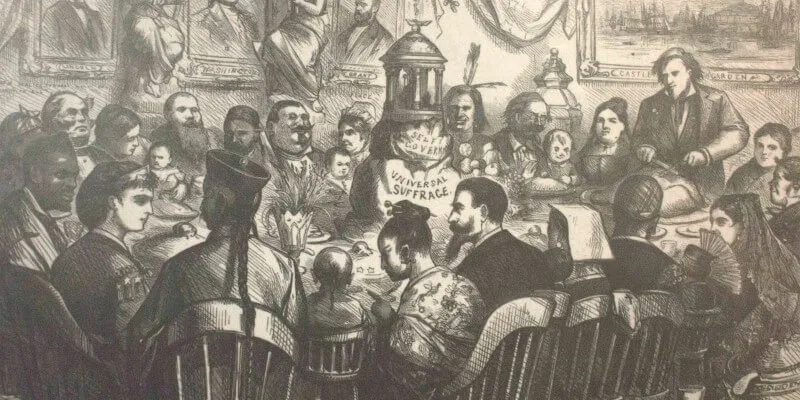Learning to say more with less was one key lesson for Jamison Dunne and 15 of his fellow first-year students enrolled in the course “Constructing Race and Citizenship in the Gilded Age” during the spring semester. UVM associate history professor Nicole Phelps challenged students to create an exhibit interpreting this turbulent period in American history (roughly 1876-1890) using political cartoons of the era as anchors to the explanatory text.
“There’s something really evocative and eye-catching about these cartoons,” says Dunne, who stayed behind on move-out day last Friday afternoon to interpret the exhibit for a few visitors in the Bailey-Howe Library lobby. “There’s an emotion here you can’t capture in newspaper stories, or letters or other documents. The cartoonists are deliberately exaggerating stereotypes to express a point of view.”
During the Gilded Age, Native Americans continued to be marginalized by Western expansion, immigrants from the Far East were arriving in greater numbers, racial tensions between African Americans and whites took on new characteristics, and women were agitating for the right to vote. Telling the story in 11 fixed panels turned out to be a daunting task. More difficult, say, than writing a 15-page term paper?
“Way more difficult,” says Dunne. “Professor Phelps really challenged us to capture what being 'an American’ meant to people during the Gilded Age. We were constantly editing and rewriting during the semester, trying to be more concise with the text.”
Student teams made an exhaustive search of cartoons in the Bailey Howe collections and online archives, picking out images that could serve to best illustrate the experience of different ethnic groups.
One cartoon, drawn by Thomas Nast for Harper’s Weekly, represents a “Thanksgiving dinner” with guests from many different racial backgrounds at the table. Dunne pointed out that the caricatures are mostly respectful, except for the pug-nosed Irishman sitting on the right of the image. “Nast was sympathetic to African Americans but was extremely anti-Catholic and anti-Irish—he tended to portray them as violent drunks.”
Students handled the curation, writing, design and installation of the entire exhibition, with support from UVM librarians Prudence Doherty and Daisy Benson.
“It was great to see the students growing as historians and as writers, which is what one expects from a history course,” said Phelps. “It was also exciting to see students bringing other talents and skills to the project, from design and detailed work with a variety of computer applications to time management and interpersonal communications.”
“It all came together in the end,” Dunne said, taking a step back and admiring the installation. “We’re really proud of it.”
The course “Constructing Race and Citizenship in the Gilded Age” is a Teacher-Advisor Program (TAP) Seminar, a writing-intensive elective for first-year students in the College of Arts and Sciences that combines an interactive course environment with academic advising.
